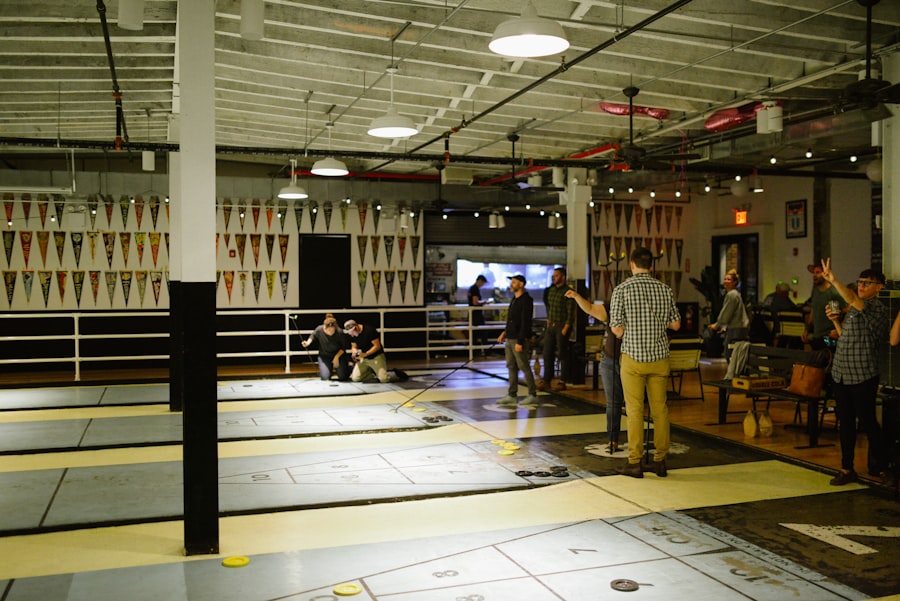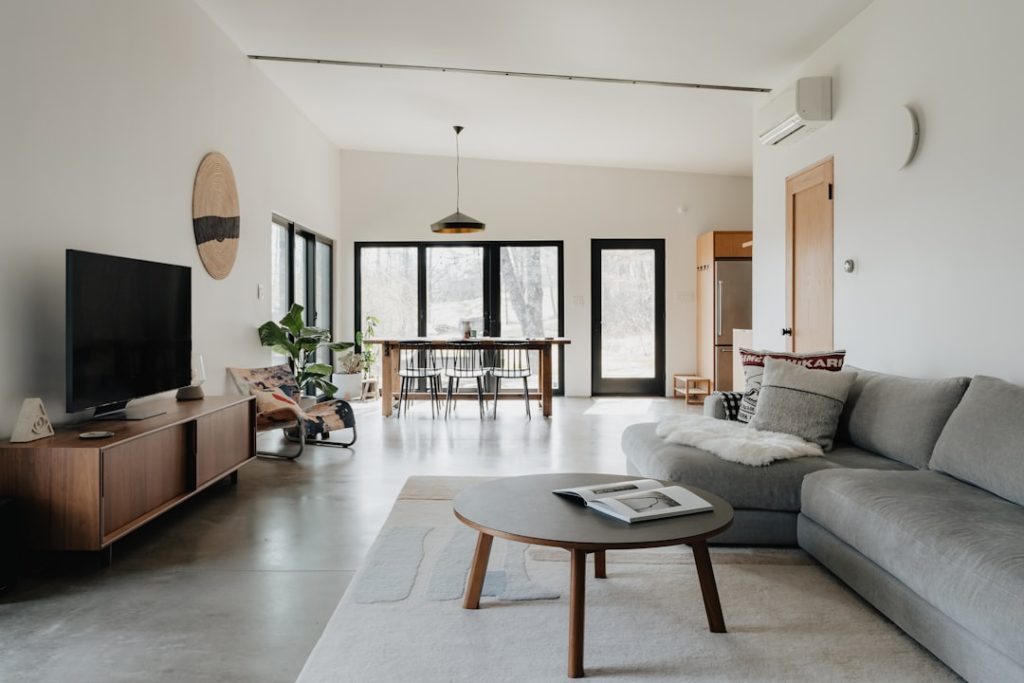A built-in entertainment center serves as a focal point in a living space, seamlessly integrating technology with design. One of the primary benefits of such a structure is its ability to maximize space efficiency. Unlike freestanding furniture, a built-in unit can be tailored to fit the specific dimensions of a room, allowing homeowners to utilize every inch effectively.
This is particularly advantageous in smaller living areas where space is at a premium. By creating a custom solution that fits snugly against walls or in alcoves, homeowners can avoid the clutter that often accompanies traditional furniture arrangements. Moreover, built-in entertainment centers offer a level of aesthetic appeal that is hard to match.
They can be designed to complement the existing architecture and decor of a home, enhancing its overall visual harmony. For instance, a built-in unit can be crafted from the same wood as the surrounding cabinetry or painted in a color that matches the walls, creating a cohesive look. This integration not only elevates the style of the room but also adds value to the home, as potential buyers often appreciate the thoughtfulness and craftsmanship that goes into custom-built features.
Key Takeaways
- Built-in entertainment centers enhance room aesthetics and provide efficient storage solutions.
- Careful planning and design ensure the entertainment center fits your space and lifestyle.
- Selecting durable materials and finishes contributes to the longevity and style of the unit.
- Integrating technology and wiring seamlessly keeps the setup organized and functional.
- Personalizing with decor and regular maintenance keeps the entertainment center attractive and practical.
Planning and Designing Your Built-In Entertainment Center
The planning phase is crucial when it comes to designing a built-in entertainment center. Homeowners should begin by assessing their needs and preferences, taking into account the types of media they consume and how they use their living space. For example, families with children may prioritize safety features and durability, while those who entertain frequently might focus on creating an inviting atmosphere with ample seating and display areas for decor.
It’s essential to consider not just current needs but also future requirements, as technology and lifestyle habits can evolve over time. Once the needs are established, the next step involves sketching out potential designs. This can be done using simple paper and pencil or more advanced design software.
Key elements to consider include the size and layout of the unit, the placement of the television and other media devices, and how to incorporate additional features like shelving for books or decorative items. It’s also important to think about traffic flow within the room; ensuring that pathways remain clear will enhance both functionality and comfort. Engaging with a professional designer can provide valuable insights and help refine ideas into a workable plan.
Choosing the Right Materials and Finishes for Your Entertainment Center

Selecting appropriate materials and finishes is vital for both the durability and aesthetic appeal of a built-in entertainment center. Wood is often a popular choice due to its versatility and timelessness. Hardwoods like oak, maple, or cherry can provide a rich, warm look that complements various design styles, from traditional to modern.
Additionally, engineered woods such as plywood or MDF can be more cost-effective while still offering a polished appearance when finished correctly. Finishes also play a significant role in the overall look and feel of the unit. Stains can enhance the natural grain of wood, while paint offers an opportunity for bold color choices that can make a statement in the room.
For those looking for a more contemporary vibe, high-gloss finishes or laminates can provide a sleek, modern appearance. It’s essential to consider not only aesthetics but also practicality; finishes should be chosen based on their resistance to wear and tear, especially in high-traffic areas where scratches or stains may occur.
Maximizing Storage and Organization in Your Entertainment Center
| Storage Solution | Average Capacity | Space Efficiency | Organization Benefit | Recommended Use |
|---|---|---|---|---|
| Adjustable Shelving | Up to 50 items | High | Customizable spacing for different item sizes | Books, DVDs, gaming consoles |
| Drawer Units | 20-30 items per drawer | Medium | Conceals clutter, easy access | Remote controls, cables, small accessories |
| Vertical Dividers | 30-40 items | High | Keeps media upright and easy to browse | DVDs, Blu-rays, video games |
| Wall-mounted Shelves | Varies by size | Very High | Frees up floor space, decorative display | Speakers, decor, small devices |
| Cable Management Systems | N/A | High | Reduces clutter and tangling | All electronic devices |
| Storage Baskets/Bins | Varies | Medium | Group similar items, easy to move | Magazines, controllers, chargers |
A well-designed built-in entertainment center should prioritize storage and organization to keep media devices, accessories, and other items neatly arranged. One effective strategy is to incorporate various types of shelving—both open and closed—to accommodate different storage needs. Open shelves are ideal for displaying decorative items or frequently used media devices, while closed cabinets can hide away less attractive items like DVDs or gaming consoles.
In addition to traditional shelving, innovative storage solutions can further enhance organization. For instance, pull-out drawers can be integrated into lower cabinets for easy access to items that might otherwise be difficult to reach. Vertical dividers can be used within cabinets to keep DVDs or games organized by category, making it easier to find what you need without rummaging through piles.
Additionally, incorporating cable management systems within the design can help keep cords hidden and untangled, contributing to a clean and streamlined appearance.
Incorporating Technology and Wiring into Your Entertainment Center
In today’s digital age, integrating technology into a built-in entertainment center is essential for functionality. This involves not only accommodating various devices such as televisions, sound systems, and gaming consoles but also ensuring that wiring is managed effectively. A well-planned entertainment center will include designated spaces for each device while considering ventilation needs to prevent overheating.
Wiring should be carefully routed through the unit to maintain an uncluttered look. This can involve drilling holes in shelves or using cable conduits that blend seamlessly with the design. Additionally, homeowners may want to consider incorporating smart home technology into their entertainment center.
This could include built-in speakers that connect wirelessly or smart lighting that adjusts based on viewing preferences. By planning for technology integration from the outset, homeowners can create a space that is not only stylish but also equipped for modern living.
Customizing Your Entertainment Center to Fit Your Needs and Style

Customization is one of the most significant advantages of a built-in entertainment center. Homeowners have the opportunity to tailor every aspect of the unit to reflect their personal style and meet their specific needs. This could mean selecting unique hardware for doors and drawers that aligns with the overall aesthetic or choosing specific lighting options that enhance the ambiance during movie nights.
Beyond aesthetics, customization can also extend to functionality. For example, if a homeowner frequently hosts gatherings, they might opt for additional seating integrated into the design or include a mini-fridge for snacks and drinks. Alternatively, those who prioritize gaming might want specialized shelving designed for consoles and accessories.
The beauty of a built-in entertainment center lies in its ability to adapt to individual lifestyles while providing an organized and visually appealing solution.
Tips for Maintaining and Cleaning Your Built-In Entertainment Center
Maintaining a built-in entertainment center is essential for preserving its appearance and functionality over time. Regular cleaning should be part of any homeowner’s routine; dusting surfaces with a microfiber cloth can prevent buildup that may scratch finishes or dull surfaces. For wooden components, using appropriate wood cleaners can help maintain luster without damaging the material.
In addition to surface cleaning, it’s important to periodically check behind the unit for dust accumulation on electronics and wiring. This not only helps maintain performance but also reduces fire hazards associated with dust buildup around electrical components. Homeowners should also be mindful of any spills or stains on surfaces; addressing these promptly with suitable cleaning solutions will prevent long-term damage.
Showcasing Your Entertainment Center with Decor and Accessories
Once your built-in entertainment center is complete, showcasing it with decor and accessories can elevate its impact within your living space. Thoughtfully chosen decorative items such as framed photos, art pieces, or plants can add personality and warmth to the unit without overwhelming it. The key is to strike a balance between functionality and aesthetics; while it’s tempting to fill every shelf with items, leaving some spaces open can create visual breathing room.
Lighting also plays an important role in showcasing an entertainment center effectively. Incorporating LED strip lights along shelves or using accent lighting can highlight decorative pieces while creating an inviting atmosphere during evening hours. Additionally, using decorative boxes or baskets within open shelving can help organize smaller items while adding texture and color to the overall design.
By carefully curating decor elements, homeowners can transform their built-in entertainment center into a stunning centerpiece that reflects their style while serving its intended purpose.



